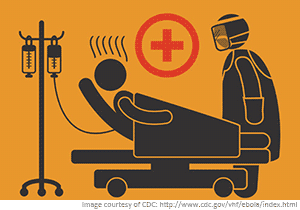
I write this reflecting on the flurry of news around recent Ebola activity. There isn’t one of us in the healthcare risk management profession who wants our organization to be the subject of unfavorable news headlines, and it’s important to take lessons learned and contemplate how to use them to improve safety of our patients, staff and providers.
Based on news reports, the recent initial discharge from the emergency department of the patient in a Texas hospital appears to have been premature. The subsequent information about what data was available in the electronic medical record (EMR) gives the appearance that there was a failure in team communication. I am hopeful that a debriefing of the event by those involved provided insight into processes and teamwork that might be shared forward. This event is another pebble in the pond for risk managers, who now watch the ripples spread as nursing staff panic, public relations practices are challenged and risk managers themselves worry about the effectiveness of their EMR in improving communication across a busy healthcare team.
I put together a short list of steps to take today to assess the temperature of your organization’s preparedness for handling any infectious disease, even an extreme situation such as an Ebola patient presenting to your facility. Patients with highly contagious diseases come through your doors every day; make sure you are ready to respond.
- Start by looking at your hospital’s healthcare provider compliance with hand washing policy. Is there room for improvement? If so, you likely also need to partner with infection prevention team members to get short blasts out to staff, reminding them about universal precautions and how to comply with standard, contact and droplet precautions.
- Follow this exercise by conducting an inventory of personal protective equipment (PPE) throughout the house to ensure there are adequate supplies for immediate readiness and ongoing care.
- Third, reach out to EMS providers serving your community to assess their level of knowledge and readiness, should they be the first responders.
- Investigate the ability of your EMR to set custom alerts allowing you to program a series of criteria (i.e. Ebola Virus Disease (EVD) Screening) that, when checked, alert the care team to follow the CDC protocol and huddle as a team to ensure no steps are forgotten.
- Meet with your public relations team to review the appropriate participants and process for delivering news at press conferences and to news reporters.
- Lastly, if individual messaging has not come to your licensed healthcare providers from your state boards of medicine and nursing about Ebola or other highly infectious diseases outlining recommended protection measures, lobby on your employees’ and the public’s behalf to get these messages out.
Additionally, share these three links to resources that can be quickly accessed to support the healthcare providers in your organization as they increase awareness of Ebola and how to be effective in identifying and caring for affected patients:
- American College of Emergency Physicians (ACEP) – Healthcare Resources for Suspected Ebola Cases: http://www.acep.org/ebola/
- Centers for Disease Control and Prevention (CDC) – Detailed Hospital Checklist for Ebola Preparedness: http://www.cdc.gov/vhf/ebola/pdf/hospital-checklist-ebola-preparedness.pdf
- Association for Professionals in Infection Control and Epidemiology (APIC) – Ebola resources for clinicians: http://www.apic.org/For-Media/News-Releases/Article?id=f732a9d7-7da0-477d-be20-ea4f67a825eb
What has your organization done to prepare for major risks like a possible Ebola outbreak? Join the discussion by leaving us a comment.
Ann Gaffey, RN, MSN, CPHRM, DFASHRM - SVP, Healthcare Risk Management and Patient Safety
Look for additional perspective on healthcare risk management and professional liability issues in our Professional Liability Risk Resource newsletters and visit our experts at ASHRM booth 425.